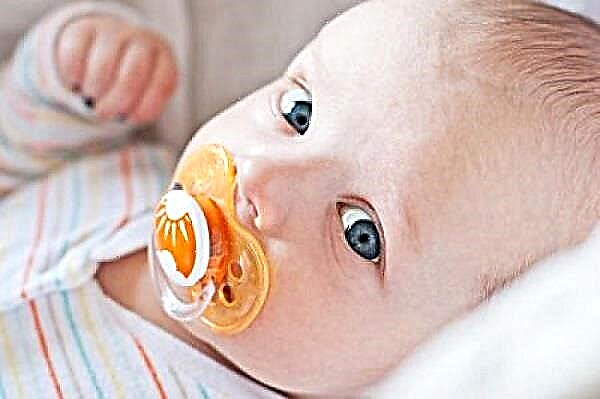Newly born babies are not protected from the world around them, therefore they require special care for themselves. Hygiene rules are followed carefully, and procedures are carried out several times a day. At the same time, it is important to know how to wipe the eyes of a newborn so as not to cause him discomfort.

How to wipe a toddler's eyes
Hygiene of healthy eyes of a newborn
Babies sleep most of the time, which makes their eyes constantly sour. This is due to the fact that the body produces a large amount of mucin, the "duty" of which is to protect and moisturize the visual organ.
When the baby is awake, the mucous fluid is evenly distributed, covering all areas of the eye. As soon as the eyelids are closed, the tears return to special bags. Some of them go into the nasal cavity. Excess liquid remains outside and, drying out, forms crusts and scabs on the eyelids.
Note! If the baby has narrow or clogged nasolacrimal ducts, then too much mucus accumulates under the eyelids, which becomes a breeding ground for microbes and provokes suppuration.
In order for the mucous membrane to always remain healthy, you need to know how to properly wipe the eyes of a newborn.
General rules
The baby should rinse his eyes after every sleep. In carrying out hygiene, the following recommendations are adhered to:
- in order not to bring an infection into the eyes of the little one, before the procedure, the mother thoroughly washes her hands with soap;
- eyes should be treated with sterile items - no paper towels and handkerchiefs;
- for convenience during the procedure, the baby is placed with his back on a flat horizontal surface (changing table).

Hygiene procedure
Do not rub dry crusts with your hands, trying to tear them off. Also, do not try to open the baby's eyelids without first moisturizing.
What you need to care for the baby
Some mothers undertake to clean the baby's eyes with a decoction of chamomile, string or other herb, without consulting a pediatrician. This should not be done - such a product can cause allergies in the child.
The best remedy is a saline solution sold in any pharmacy. If the liquid is not at hand, you can use boiled water warmed up to a temperature slightly above room temperature.
Sterile gauze swabs are moistened with the solution or wet wipes designed specifically for newborn hygiene are used.
Newborn baby eye care
Regardless of whether the little one's eye turns sour or not, hygiene is carried out regularly, not only in the morning, but also several times a day. The procedure itself is similar to the ritual:
- as soon as the baby wakes up, they take him on the arms and put him on the changing table;
- mom pours some saline into a convenient container and moistens a sterile gauze pad in it;
- to properly process the eye, move from the inner corner of the eyelids to the outer, not forgetting to slightly squeeze the gauze;
- having finished washing one eye, proceed to the next;
- after the procedure, the eyelids are blotted with a clean, dry (sterile) napkin.
In the evening, you can clean your baby's eyes while swimming. The crusts from warm water are moisturized, softened and easily removed.
Causes of inflammatory processes
Sour eyes in healthy babies should not be a concern - this is a normal physiological phenomenon. If not only a crust is observed on the eyelids, but the mucous membrane began to fester, this is already a sign of an inflammatory process. The released mass can have a different shade: white, yellow, green.
Additional Information. About discomfort, accompanied by cramps or burning sensation, the baby "beeps" with crying, whims, poor appetite. The baby constantly pulls his fists to his eyes, trying to rub them.

The eye is inflamed
The inflammation is accompanied by redness and swelling of the eyelids. Therefore, it is difficult for a baby to open eyes that are soured after a long sleep.
The main problem is why a newborn's eyelids sour strongly, m is conjunctivitis. The mucous membrane can become inflamed for several reasons:
- an infection has entered the eye;
- the child has one of the diseases of the nasopharynx;
- an allergic reaction to food, dust, animal hair, odors, etc.
A high fever will be a sign that the nature of the inflammation is viral or infectious.
Other causes of acidification
| Name | Features: |
|---|---|
| Staphylococcus aureus | The eyes of an infant can fester when infected with such a dangerous bacterium. If the microorganism is not detected in a timely manner and therapy is not started, the inflammation will quickly spread to other organs, developing into sepsis. |
| Adenovirus infection | Not only does the baby's eyes turn sour, but also there is abundant mucus from the nose. The disease is accompanied by high fever and sore throat. |
| Dacryocystitis | The cause of acidity of the eyes is embryonic tissue that clogs the lacrimal canals. Not all babies rupture the membrane after birth, making it difficult for fluid to drain. If the eye festers, it means that an infection has been added to the pathology. |
Any of the described reasons require consultation with a doctor. It is difficult to make the correct diagnosis on your own, which will lead to the wrong choice of therapy.
Conjunctivitis as a cause of suppuration
Not every eye inflammation is accompanied by suppuration, if the treatment is correct and timely. Various reasons contribute to the appearance of unpleasant discharge. The most typical factor for newborns is inflammation of the conjunctiva, which the baby can get when passing through the birth canal, while in the prenatal center, and also upon arriving home.
There are several types of this disease, they have common symptoms:
- the skin of the eyelids swells;
- eyes begin to water;
- squirrels turn red;
- eyelids after sleep due to sticking do not open well;
- pus is often present in mucous secretions.

Inflammation of the conjunctiva
Unpleasant sensations in the eyes cause discomfort. The infant reacts painfully to bright light. The child becomes restless, does not sleep well, is capricious during feedings. All this negatively affects the general condition of the child's body.
Inflammation care principles
Rules for the use of medicines
To achieve an effect in treatment, medicines are selected taking into account the reasons that caused the disease:
- with viral etiology, the eyes are washed with antiseptic drugs, and antiviral drops are also prescribed;
- if bacteria are the cause, appropriate ointments and solutions are used;
- with allergic conjunctivitis, antihistamines will be required (both in drops and tablets).
When your doctor detects a blockage in your tear ducts, you will need other antiseptics to flush. The ophthalmologist will first recommend daily massages of the appropriate points on the eyelid.
Traditional therapy
If the toddler is not allergic to herbs, recipes for alternative therapy can be applied at home. They should not become the basis of treatment, but only supplement the recommendations offered by the specialist.
You can wipe the inflamed eyes of the little one with the following means:
- decoction of chamomile, calendula or string;

Folk remedy
- cornflower infused with boiling water;
- weak brewing of black tea (regular, without additives and flavors).
Milk lavage (cow or mother's) is not permitted in all cases. Therefore, before using this option, it is worth consulting a pediatrician.
Daily care
In case of inflammation, eye hygiene becomes a mandatory procedure, which is carried out according to the algorithm described above. If saline or ordinary water was used for treatment in a healthy child, then additional measures are needed with an eye disease that develops.
After the mother has washed the baby, she does the following, taking into account the cause of the inflammation:
- with bacterial or viral conjunctivitis, drops prescribed by a doctor are instilled into the eyes or lubricate the eyelids with ointment;
- when the lacrimal canals are blocked, antiseptics are used, alternating with herbal decoctions or furacilin solution.
To exclude an allergic reaction, the baby's contact with the irritant is completely excluded.
Komarovsky about pus in the eyes of a baby
Conjunctivitis is the general name for a number of inflammatory processes. To begin treatment of the disease, Dr. Komarovsky recommends identifying the root cause that caused the suppuration of the eye. It should be borne in mind that inflammation of the conjunctiva can be combined with problems that have arisen in closely located organs: nose, ear, larynx.
It does not matter how the mother wipes the eyes of the newborn, the suppuration cannot be eliminated by a hygienic procedure. Antiviral or antibacterial drugs will help here, but a specialist should select them.
How to treat a child's eyes with conjunctivitis
With a purulent inflamed conjunctiva, the treatment of the baby's eyes is carried out in compliance with the following rules:
- before using the medicine, the eyes of the little one are wiped with a sterile cotton swab moistened with water or saline;
- all movements occur from the outer corner to the bridge of the nose;
- use separate tampons for each eye;
- if drops are used in the treatment, then the liquid medicine is dripped into the inner corner of the eye;
- the ointment is evenly distributed, laying it under the lower eyelid.

Conjunctivitis treatment
Important! Even if one eye of the baby is inflamed, both should be treated so that the problem does not affect the second conjunctiva.
What not to do
If, with a slight physiological acidification of the eye, the mother can still independently treat the baby's eyelids, then in the presence of purulent discharge, one should not engage in “artisanal” treatment.
The first step to a baby's recovery is to see a doctor at the initial signs of inflammation.
Sour eyes of the baby
In newborns, the eyes turn sour due to blockage of the ducts. Usually, the embryonic plug comes off on its own. If the baby's eyes continue to water 10 days after arriving home, the doctor states dacryocystitis.
Care rules
At first, no medication is required. Stagnant tears syndrome will help to eliminate the massage of the nasolacrimal canals. If the gelatinous film does not collapse, the manipulations are supplemented by hygienic procedures using antiseptic agents.
If, after the massage, pus is released from the peephole, it must be wiped off with a cotton or gauze swab moistened with herbal decoction or saline. After that, drip the eyes with medicinal drops, which the doctor will assign.
Which doctor to seek advice from
Any type of eye disease requires a visit to an ophthalmologist. If you cannot get to him in time for an appointment, you can first visit a local pediatrician or call a family doctor at home. They will examine the baby and help make the correct diagnosis, as well as give recommendations on how to wash the eyes of the newborn.
Prevention of eye inflammation
It is impossible to completely avoid acidification of the baby's peephole. But to really minimize the risk of developing inflammatory processes, if you follow these rules:
- do not ignore hygiene procedures, washing the eyes of the little one several times a day;
- hypothermia of the baby should not be allowed, which creates favorable conditions for viral infections;
- contact of the child with patients suffering from colds, diseases of the respiratory tract, conjunctivitis should be excluded;
- maintain an optimal humidity level in the room;
- improve the child's immunity by hardening and balanced nutrition;
- do not self-medicate.
If the toddler often crawls to the eyes, it is recommended to put on cotton gloves on the cams. Another preventive measure to avoid conjunctivitis is to change your bed linen daily.
To relieve the baby of discomfort and not provoke the development of inflammation, the little one is shown to a specialist at the first symptoms of eyelid acidification. The doctor will give advice on how to rinse the eyes of the child, and also select the correct therapy if necessary.



